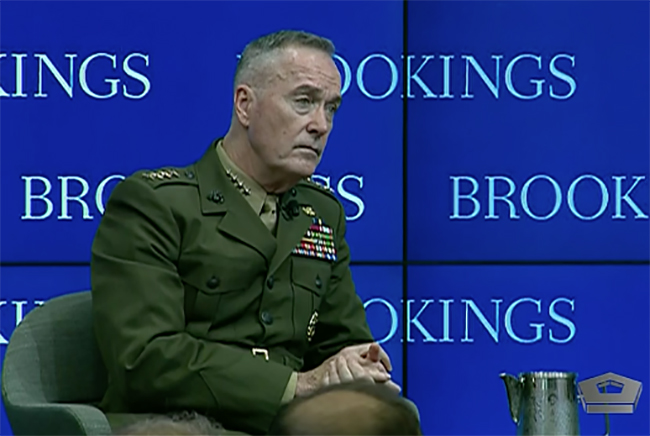
Chairman of the Joint Chiefs of Staff Gen. Joseph Dunford appears May 29, 2019, at the Brookings Institution during an event focused on the "national security landscape facing America." DOD screenshot.
While the Air Force has put forth plans to increase the size of its force structure, Chairman of the Joint Chiefs of Staff Gen. Joseph Dunford said May 29 that given the choice between increasing in size and increasing in quality, the latter is needed in the face of budget realities.
Speaking at the Brookings Institution in Washington, D.C., Dunford said the military cannot have an effective increase in force structure without proper training, equipment, and leadership. “What I would say to those coming behind me is: Make sure that if we grow, … you need to do [it] in a way where it is meaningful capability, balanced capability. And when you have to make a choice between capacity and capability, I would go with capability.”
Dunford has announced his retirement, and President Donald Trump has nominated Army Chief of Staff Gen. Mark Milley to be his successor.
The Air Force last fall put forth its “Air Force We Need” plan, saying the service needs to increase its total number of squadrons to 386 to meet requirements outlined in the National Defense Strategy. The plan also included sizeable increases USAF’s tanker, bomber, and fighter fleets. However, it did not include budget realities, and the fiscal 2020 budget request did reflect changes outlined in the plan.
Since 2015, the Pentagon has seen stabilizing and then increasing funding, which has helped it address readiness problems, Dunford said. The additional money has helped with ammunition shortfalls, a lack of spare parts, limited training, and other areas since the “bill payer” in tight budgets has been the units not deployed, he said. In more recent years, funding has helped invest in the aviation enterprise and ground vehicles.
“We’re now, what I hope to be, four years into stable and adequate levels of funding, assuming that we get fiscal year ’20 at or about what the president’s budget reflects,” Dunford said. “And that has made a quantifiable impact on the level of readiness that we have.”
However, there is more to be done. While readiness has improved, the erosion in the US competitive advantage over adversaries has continued over the past 20 years, he said.
“Our competitive advantage from where it was in 2000 to where it is today has eroded over time,” he said “So as I look forward and I think about readiness, what I think about is ensuring we that we make the investments necessary to have a competitive advantage in 2024 and 2025, as well as today.”
